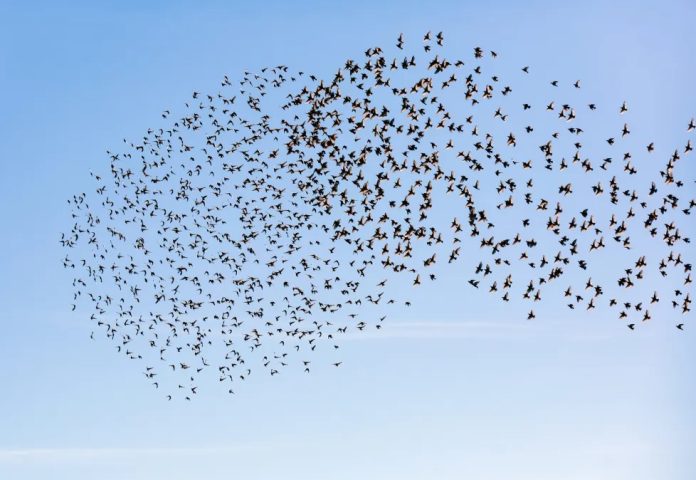What are common flight patterns of birds and why do they do it.
Birds are among the most fascinating creatures in the animal kingdom, primarily due to their ability to fly. This extraordinary capability is not just for movement; it plays a critical role in their survival. Different species of birds exhibit a variety of flight patterns, each tailored to their ecological needs and evolutionary history. In this article, we will explore the common flight patterns of birds and delve into the reasons behind these behaviors.
Table of Contents
ToggleTypes of Bird Flight Patterns
Birds use various flight patterns that can be broadly categorized based on their wing movements and the purpose of their flights. The primary flight patterns include flapping, gliding, soaring, and hovering.
- Flapping Flight
- Description: Flapping flight involves the continuous up-and-down motion of the wings to generate lift and thrust. It is the most energy-intensive form of flight.
- Purpose: This type of flight is crucial for takeoff, landing, and maneuvering in the air. Birds like sparrows, pigeons, and hummingbirds primarily use flapping flight for short-distance travel and quick movements.
- Gliding Flight
- Description: In gliding flight, birds extend their wings and glide through the air with minimal wing movement. They lose altitude slowly as they move forward.
- Purpose: Gliding conserves energy compared to flapping. Birds such as albatrosses and gulls use gliding flight to travel long distances over the ocean, utilizing wind currents to maintain altitude and direction.
- Soaring Flight
- Description: Soaring involves riding thermal updrafts or other rising air currents to gain altitude without flapping. Birds make circular patterns to stay within these updrafts.
- Purpose: This flight pattern is energy-efficient and allows birds to cover vast distances with minimal effort. Raptors like eagles and hawks, as well as vultures, are known for their soaring capabilities.
- Hovering Flight
- Description: Hovering flight is when a bird remains stationary in the air by rapidly flapping its wings. This requires precise control and significant energy expenditure.
- Purpose: Hovering is essential for feeding, especially for birds like hummingbirds that feed on nectar. Kingfishers also hover to spot prey in the water before diving.
Reasons Behind Different Flight Patterns
The variety in flight patterns among birds is driven by several factors, including evolutionary adaptations, environmental conditions, and specific survival needs.
- Evolutionary Adaptations
- Birds have evolved different flight patterns to suit their ecological niches. For example, birds of prey have strong, broad wings adapted for soaring, allowing them to conserve energy while searching for food over large territories. On the other hand, hummingbirds have evolved to have incredibly rapid wing beats, enabling them to hover efficiently.
- Environmental Conditions
- The environment plays a crucial role in shaping flight patterns. Birds living in open spaces with abundant wind currents, such as seabirds, often glide and soar to travel long distances with minimal effort. Forest-dwelling birds, like woodpeckers, need flapping flight for quick maneuvers among trees.
- Survival Needs
- The primary reason behind different flight patterns is the need to survive and reproduce. Efficient flight patterns help birds find food, escape predators, migrate, and locate mates. For instance, the migratory patterns of many bird species involve long flights that require energy-efficient soaring and gliding.
Specific Examples of Bird Flight Patterns
To illustrate the diversity and purpose of bird flight patterns, let’s look at some specific examples:
- Albatrosses: Known for their exceptional gliding abilities, albatrosses can travel thousands of miles over the ocean without flapping their wings frequently. They use dynamic soaring, a technique that exploits the wind gradient over the sea surface.
- Hummingbirds: These tiny birds are masters of hovering flight, thanks to their unique wing structure and rapid wing beats. They can remain stationary to feed on nectar from flowers, making them highly efficient pollinators.
- Eagles: Eagles are powerful soarers, using thermal updrafts to gain altitude and travel long distances. Their broad wings and keen eyesight make them efficient hunters from great heights.
- Pigeons: Commonly found in urban areas, pigeons rely on flapping flight for quick and agile movements. Their strong wing muscles allow them to take off swiftly and navigate through complex environments.
Understanding the common flight patterns of birds and the reasons behind them reveals the intricate relationship between these creatures and their environment. Each flight pattern is a result of millions of years of evolution, shaped by the need to survive and thrive in diverse habitats. From the energy-efficient soaring of eagles to the rapid hovering of hummingbirds, the flight of birds remains a captivating subject that continues to inspire awe and wonder.








